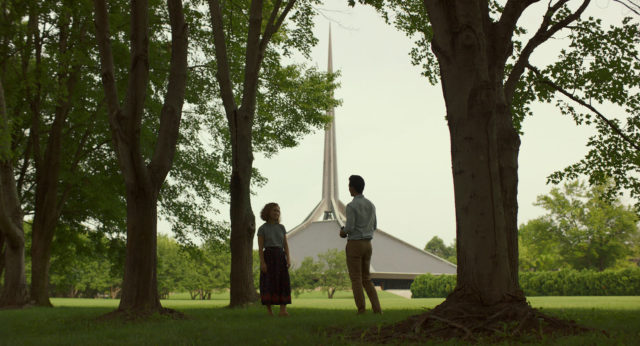
A father is sick and the son is beckoned to his side. While the son waits for his father to die, he meets another wayward soul: a girl, stuck in neutral, waiting for her real life to begin. The set-up may be familiar but the execution is anything but.
This is Columbus, the first movie from South Korean-born writer/director Kogonada, a video essayist of considerable reputation. As an essayist, Kogonada’s acute eye zeros in on directorial traits, fetishes and form. Little of that is lost in the leap to feature-length narrative, giving Columbus a considerable edge over other movies.
Now to the players and the story: Jin (John Cho) is the son of an architecture scholar who has fallen into a coma from which he will not wake. Doing what he must, Jin puts his work in Seoul, South Korea, on hold to be by his father’s side — even though dear old dad was rarely by his. Casey (Haley Lu Richardson) is a young architecture enthusiast who abandoned her studies when mother needed some parenting of her own. As is habit in these movies, Jin and Casey come together and enjoy each other’s company while biding their time in purgatory. He waits for his father to die; she waits for her life to start.
Standard stuff, but in the capable hands of Kogonada, Columbus is fresh.
Known as a mecca for modernist architecture, Columbus, Indiana, possess buildings and structures crafted by I.M. Pei, Eero Saarinen, Richard Meier and many others. These buildings are much more than backdrop; they are the reason Jin’s father was in the city and why Casey won’t leave. Kogonada and cinematographer Elisha Christian match these monuments with a deliberate and spare filming style that makes every shot count and wastes nothing.
This doesn’t just make Columbus beautiful to watch, but it also provides the narrative thrust that keeps the story going. Both Jin and Casey lift their heads toward the sky and wonder what secrets these buildings hold. Casey has her ideas and for the most part, they work. But Jin is looking for something a little deeper. He is wondering what his father saw in these buildings. If he can find it, will he understand his father better?
The same can be asked of Kogonada, an ardent admirer of Japanese filmmaker Yasujirô Ozu. Can a director better understand another director, a father figure of sorts, by cribbing their style? Can they understand the world through their eyes? Isn’t that what cinema always aspires to: communicate an experience by looking through someone else’s eyes?
Take the scene where Jin asks Casey what a building means to her. Casey smiles and starts to explain, but Kogonada drops the sound out. We are left in silence with only her smiling face to study as she describes something important to her. Her hands trace an invisible box as if she is illustrating the frame of a building.
She might as well be describing the movie frame.
On the Bill: Columbus. Oct. 19–21, The Boedecker Theater at the Dairy Arts Center, 2590 Walnut St., Boulder.
Talkback with producer Danielle Renfrew Behrens follows the Thursday, Oct. 19 screening. thedairy.org
7:30 p.m., Saturday, Nov. 4, International Film Series,
Muenzinger Auditorium, University of Colorado Boulder.
internationalfilmseries.com














